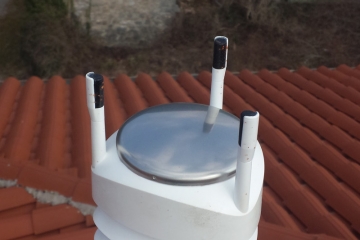
Two weather stations Vaisala WXT520 measuring weather parameters - wind speed and direction, liquid precipitation parameters, barometric pressure, temperature and relative humidity have been procured as part of the ŽIVO! project.
The first meteorological station was mounted on 20 March 2015 on the roof of the Science and education center Speleo House in the municipality of Lanišće, and the second on 13 April 2015 on the high part of the water tank St. Jelena in the municipality of Oprtalj. The stations are connected to a computer where data is stored in the database every 5 minutes. The data will be processed and analyzed and the implementation of this data will be presented in the selected sections of the Monograph of the project and the scientific study of the project. The objectives of monitoring specific climate parameters on the default locations of the project – basins of the springs Sv. Ivan and Bulaž, could not be met without these weather stations. After the conclusion of the project these weather stations will continue providing users (Istrian Waterworks and ZRC users) with information about the recent state of climate conditions, with the aim of capitalization of project results. To view the current weather conditions in Vodice please click HERE.
This type of weather station has an ultrasonic sensor that uses ultrasound to measure wind direction and speed instead of standard blades or propellers. The sensor has no moving parts, making it independent of some restrictions that normally apply to mechanical gauges, such as inertia or friction. The sensor has three ultrasound probes in the shape of an equilateral triangle. Wind measurement is based on how long does it take for the signal to travel from one to the other probe. The amount of rain is also measured in a very different way than in conventional weather stations that typically have a ‘see-saw’ that tilts for every inch of rainfall. Vaisala weather station has a sensor for measuring rainfall, which measures the impact of individual rain drops falling on the steel surface by means of a piezoelectric detector. The sensor measures the acoustics, that is, the volume of each stroke. A greater stroke makes a stronger acoustic signal than a smaller drop of rain. Piezoelectric detector converts the sound signals into voltage. The total amount of rain is calculated as the sum of the individual voltage signals at a given time and at a certain area that is 90 mm in diameter.
Back to project page Speleo House | Science and education center
Speleo House | Science and education center